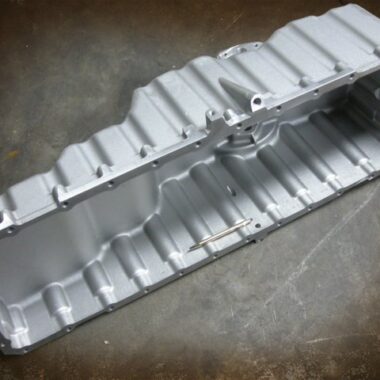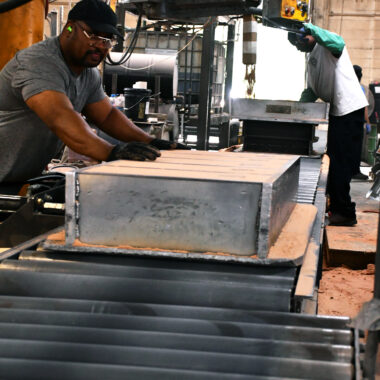The Ultimate Overview to Aluminum Casting: Specialist Insights and Finest Practices
The Ultimate Overview to Aluminum Casting: Specialist Insights and Finest Practices
Blog Article
Learning Light Weight Aluminum Casting: a Deep Dive Into the Different Techniques Available
Light weight aluminum casting stands as a cornerstone of modern manufacturing processes, offering adaptability and precision in creating elaborate layouts and practical parts. As industries progressively turn to aluminum for its lightweight yet resilient buildings, mastering the different spreading methods comes to be paramount. From the standard technique of sand casting to the complicated processes of financial investment casting and pass away casting, each strategy provides one-of-a-kind difficulties and benefits. Comprehending the subtleties of these techniques is essential for making certain the high quality and performance of the casting procedure. In this exploration of light weight aluminum spreading methods, we will certainly drop light on the details of each technique, giving insights that might revolutionize your technique to light weight aluminum casting.

Sand Spreading Strategy Introduction
The Sand Casting strategy's convenience and extensive application make it a cornerstone in mastering light weight aluminum casting procedures. This method involves developing a mold and mildew from a mix of sand and a binder, such as clay, to form detailed shapes for casting liquified light weight aluminum. Sand casting is a preferred option due to its fairly inexpensive, simplicity of modification, and capacity to produce intricate geometries with high precision.
The procedure begins with the production of a pattern, normally made of timber or metal, which is pushed right into the sand to produce a mold and mildew tooth cavity. When the pattern is removed, the mold and mildew cavity is full of molten aluminum, which strengthens to take the shape of the pattern. After cooling and solidification, the sand mold and mildew is escaped, exposing the light weight aluminum casting.
Sand spreading is widely utilized in numerous industries, including auto, aerospace, and production, as a result of its flexibility in creating both big and tiny aluminum elements (aluminum casting). Its versatility to intricate designs and cost-effectiveness make it a favored selection for many aluminum casting applications
Irreversible Mold And Mildew Casting Process Described
Discovering the intricacies of aluminum casting, the Long-term Mold and mildew Casting procedure supplies a refined method for producing top notch parts with accuracy and performance. Unlike sand spreading, permanent mold casting utilizes a reusable mold usually made from steel or iron to form the liquified light weight aluminum. The mold and mildew is preheated to a certain temperature level to boost the flowability of the steel prior to pouring. This process helps achieve a smoother surface finish and tighter tolerances contrasted to sand spreading.
Irreversible mold casting can be classified right into two main types: gravity spreading and low-pressure spreading. Gravity spreading involves pouring the liquified metal into the mold and mildew utilizing gravity, while low-pressure casting utilizes reduced pressure to load the mold and mildew tooth cavity. Both methods supply benefits in article terms of lowering porosity and enhancing mechanical residential properties.
Die Casting: Drawbacks and benefits
Grasping the details of die spreading involves recognizing its distinctive advantages and downsides in the realm of aluminum component production. One crucial benefit is the high-speed manufacturing capability of die casting, enabling for the mass manufacturing of intricate shapes with tight tolerances.
Nevertheless, pass away spreading does come with its own set of drawbacks. One significant downside is the high initial tooling expense related to developing the dies used while doing so (aluminum casting). These molds can find more be costly to create, making die casting less cost-effective for little manufacturing runs. The procedure is not as versatile when it comes to create modifications contrasted to other casting techniques like sand casting. Despite these limitations, the benefits of die spreading usually surpass the negative aspects, making it a recommended option for lots of aluminum casting applications.
Financial Investment Casting Applications and Benefits
Structure on the advantages of die casting, financial investment spreading supplies a functional technique for producing detailed light weight aluminum components with one-of-a-kind advantages in various applications. Financial investment casting, also called lost-wax casting, masters producing complex forms that would be difficult or tough to achieve via other approaches. This technique is extensively utilized in sectors such as aerospace, automobile, and precious jewelry making.
Among the essential advantages of investment spreading is its capacity to create near-net form parts, lessening the need for extra machining and reducing material waste. This causes price savings and faster manufacturing times contrasted to conventional machining procedures. Additionally, investment spreading permits the production of components with excellent surface coatings and limited tolerances.
In the aerospace industry, investment spreading is preferred for its ability to create light-weight yet solid components important for airplane performance. The automobile market gain from investment casting for creating elements with high dimensional precision and intricate layouts. In general, financial investment casting provides a precise and affordable service for producing complex light weight aluminum components throughout numerous industries.

Lost Foam Spreading: Exactly How It Works
Shed foam casting, likewise known as evaporative-pattern casting, is an approach for creating elaborate steel components by utilizing foam patterns that evaporate throughout the casting process. When liquified steel is poured into the mold and mildew, the foam evaporates due to the warmth, leaving behind a cavity that is after that loaded by the metal.
One of the crucial benefits of shed foam casting is its capability to create intricate shapes with detailed details that might be testing to attain with other casting techniques. In addition, the procedure can be cost-effective as it gets rid of the requirement for cores and enables the combination of several elements right into a solitary component. Nonetheless, it requires careful control of go to these guys the process parameters to guarantee appropriate foam evaporation and metal circulation.
Verdict
In verdict, grasping aluminum casting entails understanding and making use of different methods such as sand spreading, long-term mold casting, pass away casting, investment spreading, and shed foam casting. Each technique has its very own advantages and applications in the manufacturing procedure. By acquainting oneself with these different approaches, suppliers can select the most ideal casting technique for their details requirements and requirements, inevitably causing reliable and successful manufacturing of aluminum parts.
From the standard method of sand spreading to the complicated procedures of investment spreading and die spreading, each method presents special challenges and benefits. In this expedition of light weight aluminum casting methods, we will lose light on the complexities of each approach, providing understandings that could reinvent your method to light weight aluminum casting.

Report this page